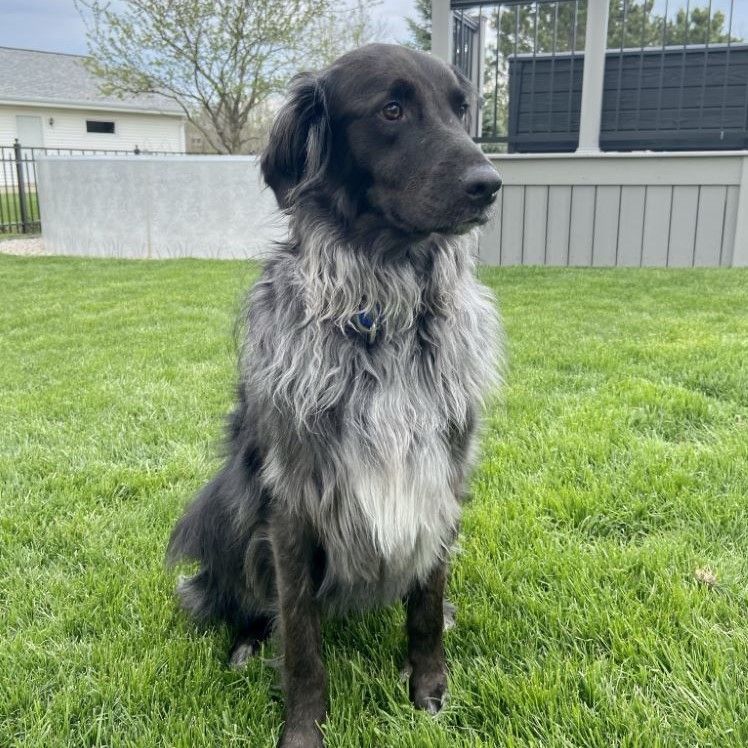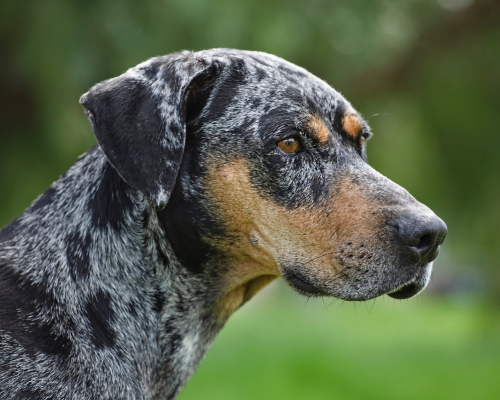Blue Heeler (Cattle Dog) Golden Retriever Mix: Full Guide
Blue Heeler (Cattle Dog) Golden Retriever Mix: Full Guide

Vet Reviewed

By: Sarah Hodgson
December 13, 2023
Table of Contents
The Blue Heeler Golden Retriever mix is a unique and fascinating crossbreed that combines the intelligence and loyalty of the Blue Heeler (Cattle Dog) with the friendly and affectionate nature of a Golden Retriever.
In this article, we will explore everything you need to know about this mixed breed, from their appearance and temperament to their exercise and care requirements. Whether you're considering adding a Blue Heeler Golden Retriever mix to your family or simply curious about this wonderful mix, you've come to the right place.
So let's dive in!
Breed Quick Overview
Height:
17 - 24 inches
Weight:
35 - 55 pounds
Lifespan:
11 - 15 years
Suitable for:
Families, young couples
Colors:
Temperament:
Energetic, Intelligent, Loyal, Playful, Adaptable, Responsive
What Does a Blue Heeler Golden Retriever Look Like?
The Blue Heeler Golden Retriever mix, also known as a "Blue Retriever," is a stunning dog with a unique blend of physical traits inherited from its purebred parent breeds.
These dogs typically have a medium to large size, with a muscular build and a well-proportioned body. Their heads are broad and slightly rounded, with expressive dark eyes that convey intelligence and alertness. The ears can vary in shape, from the Blue Heeler's erect ears to the Golden Retriever's floppy ears. One of the most striking features of this mix is its beautiful coat, which can come in a range of colors, including blue, black, and cream which we mentioned in the breed overview.

History and Origins of the Blue Heeler Golden Retriever Mix
To better understand the Blue Heeler Golden Retriever mix, it's important to dive into the history and origins of its parent breeds.
The Blue Heeler, also known as the Australian Cattle Dog, was originally bred in Australia for herding cattle. With their exceptional agility and endurance, Blue Heelers quickly became indispensable on Australian ranches. The Golden Retriever, on the other hand, originated in Scotland and was developed as a breed specifically for retrieving games during hunting expeditions. Their gentle temperament and superb retrieving abilities made them a favorite choice among hunters. The Blue Heeler Golden Retriever mix combines the best qualities of both breeds, resulting in a dog that is not only an excellent herder but also a devoted family companion.
Appearance of the Blue Heeler Golden Retriever Mix
The Blue Heeler Golden Retriever mix showcases a unique blend of physical characteristics inherited from its parent breeds.
- Have strong and muscular builds, with a well-proportioned body and a deep chest.
- Have broad heads with a slightly rounded skull and a medium-length muzzle.
- Have dark and expressive eyes, reflecting their intelligence and alertness.
- Have ears can be either erect, like those of the Blue Heeler, or floppy, like those of the Golden Retriever.
One of the most remarkable features of this mix is their coat, which can vary in color and texture. Some Blue Heeler Golden Retriever mixes have a short and dense coat, while others have a longer and wavier coat.
Temperament of the Blue Heeler Golden Retriever Mix
When it comes to temperament, the Blue Heeler Golden Retriever mix is known for being a loyal, intelligent, and affectionate dog. These dogs are highly trainable and eager to please, making them a joy to work with.
They are also incredibly loyal to their families and form strong bonds with their owners. The Blue Heeler Golden Retriever mix is a social dog that generally gets along well with children and other pets when properly socialized from a young age. However, it's important to note that they may exhibit some herding instincts inherited from the Blue Heeler parent, which could lead to them trying to herd children or other animals. Early training and socialization can help mitigate these instincts and ensure a well-rounded and well-behaved dog.
Health Problems of the Blue Heeler Golden Retriever Mix
Like all mixed breeds, the Blue Heeler Golden Retriever mix may inherit certain health issues from its parent breeds. Some of the common health problems that may affect this mix include hip dysplasia, elbow dysplasia, progressive retinal atrophy (PRA), and certain types of cancers.
Major Concerns
Hip Dysplasia
Progressive Retinal Atrophy (PRA)
Elbow Dysplasia
Minor Concerns
Deafness
Allergies
Entropion (eyelid abnormality)
Note
Regular vet check-ups and a proper diet can go a long way in ensuring the overall health and well-being of a Blue Heeler Golden Retriever. It's also important to provide them with regular exercise and mental stimulation to prevent obesity which we will go over now.
Exercise Requirements for the Blue Heeler Golden Retriever Mix
The Blue Heeler Golden Retriever mix is an active and energetic dog that requires regular exercise to keep them physically and mentally stimulated jus like both their parents.
These dogs thrive on activities that challenge their intelligence and agility. Daily walks, playtime in a securely fenced yard, and interactive games such as fetch or puzzle toys are all great ways to keep your Blue Heeler Golden Retriever mix happy and healthy. They also excel in dog sports like obedience, agility, and even herding trials. It's important to note that these dogs have a high energy level and may become destructive or develop behavioral problems if not given enough exercise and mental stimulation.

Care Requirements for the Blue Heeler Golden Retriever Mix
In addition to regular exercise, the Blue Heeler Golden Retriever mix has specific care requirements to keep them in optimal health we'll go over grooming, dental care, and diet needs.
Grooming:
Regular grooming is essential to keep your Blue Heeler Golden Retriever mix looking and feeling their best. Here's what you need to know:
Brushing:
- Frequency: Brush your dog's coat at least 2-3 times a week to manage shedding and prevent matting.
- Tools: Use a slicker brush for the Blue Heeler's short coat and a comb for the Golden Retriever's longer hair.
- Baths: Bathe your dog as needed, typically every 6-8 weeks or when they get dirty.
Ears, Eyes, and Nails:
- Ears: Check and clean the ears regularly to prevent wax buildup and reduce the risk of infections.
- Eyes: Wipe away any tear stains and check for signs of redness or irritation.
- Nails: Trim your dog's nails every 2-4 weeks to prevent overgrowth and discomfort.
Seasonal Considerations:
- Seasonal Shedding: Be prepared for increased shedding during seasonal changes, and adjust grooming frequency accordingly.
Dental Care:
Maintaining good dental hygiene is crucial for Blue Retrievers health:
Brushing:
- Frequency: Aim to brush your dog's teeth 2-3 times a week using a canine toothbrush and toothpaste.
- Chews and Toys: Provide dental chews or toys designed to promote oral health and reduce plaque and tartar.
Regular Check-ups:
- Veterinary Visits: Schedule regular dental check-ups with your veterinarian to monitor oral health and address any emerging issues.
Dietary Considerations:
- Dental-Friendly Diet: Choose a high-quality dog food that promotes dental health, and consider options with kibble designed to reduce tartar.
- Avoid Table Scraps: Limit the intake of human food, especially items that can contribute to dental issues.
Diet:
A well-balanced and nutritious diet is vital to support the health and energy levels of your Blue Heeler Golden Retriever mix.
Protein and Nutrients:
- High-Quality Dog Food: Select a dog food with a balance of high-quality protein, fats, and essential nutrients to meet your dog's dietary needs.
- Life Stage Considerations: Choose food appropriate for your dog's life stage (puppy, adult, senior).
Feeding Schedule:
- Consistency: Establish a consistent feeding schedule to regulate your dog's metabolism and help with training.
- Portion Control: Be mindful of portion sizes to maintain a healthy weight and prevent overfeeding.
Hydration:
- Fresh Water: Ensure your dog has access to fresh, clean water at all times to support overall health and hydration.
Special Dietary Needs:
- Allergies or Sensitivities: If your dog has specific dietary requirements, consult with your veterinarian to choose an appropriate diet that meets their needs.
Do Blue Heeler Golden Retriever Mixes Make Good Family Dogs?
To put it simply yes, of course they do!
Yes, Blue Heeler Golden Retriever mixes can make excellent family dogs. With their loyal and affectionate nature, they form strong bonds with their families and are known to be great with children. They are generally friendly and sociable, making them a good fit for households with other pets as well.
However, it's important to remember that every dog is an individual, and their behavior will depend on various factors, including genetics, socialization, and training. Early socialization and consistent, positive training techniques are key to raising a well-behaved and well-adjusted Blue Heeler Golden Retriever mix.
Why Get a Blue Heeler Golden Retriever Mix?
There are several reasons why getting a Blue Heeler Golden Retriever mix can be a great choice for dog lovers.
- Firstly, they combine the intelligence and trainability of both parent breeds, making them highly trainable and eager to please. T
- They are also loyal and devoted to their families, forming deep bonds with their owners.
- Additionally, their unique appearance and striking coat colors make them stand out in a crowd.
What are the Pros and Cons of Getting a Blue Heeler Golden Retriever Mix?
Before we end the guide let's go over the pros and cons of bringing a Blue Heeler Golden Retriever mix into your home.
Pros of Getting a Blue Heeler Golden Retriever Mix:
- Intelligence: Pro: These mixes are highly intelligent, making them quick learners and responsive to training commands.
- Loyalty: Known for their loyalty, Blue Heeler Golden Retriever mixes often form strong bonds with their families and make excellent dogs.
- Versatility: Combining the herding instincts of the Blue Heeler with the friendly nature of the Golden Retriever results in a versatile dog suitable for various activities and environments.
- Adaptability: Their adaptable nature allows them to fit well into different living situations, from apartments to houses with yards.
- Family-Friendly : Pro: Generally good with children and other pets, making them a great choice for families.
- Protective Instincts: Pro: They often exhibit protective instincts, enhancing the sense of security for their owners.
- Exercise Companionship Pro: Perfect for active individuals or families, as they enjoy and thrive with regular exercise and outdoor activities.
- Social Nature: Pro: Typically sociable, making them well-suited for social interactions with other dogs and people.
Cons of Getting a Blue Heeler Golden Retriever Mix:
- High Energy Levels: Con: Their energy levels can be demanding, requiring consistent exercise and mental stimulation to prevent boredom and behavioral issues.
- Grooming Requirements: Con: Depending on the coat inherited, grooming needs may vary, requiring regular brushing and maintenance.
- Herding Instincts: Con: The herding instincts from the Blue Heeler side may lead to attempts to herd family members or other pets.
- Training Commitment: Con: Their intelligence can result in stubbornness if not properly trained and given sufficient mental challenges.
- Health Issues: Con: Like all breeds, they may be prone to certain health issues inherited from their parent breeds, such as hip dysplasia or progressive retinal atrophy.
- Space Requirements: Con: They may not be suitable for apartment living if they do not receive adequate exercise and mental stimulation.
- Chewing Habits: Con: They may have a tendency to chew, especially during teething, so providing appropriate chew toys is essential.
- Socialization Needs Con: Lack of proper socialization may lead to shyness or aloof behavior

The Bottom Line
So there you have it, the Blue Heeler Golden Retriever mix is a fascinating crossbreed that combines the best traits of the Blue Heeler (Cattle Dog) and the Golden Retriever.
With their unique appearance, intelligence, and loyalty, these dogs make excellent family dogs and working dogs. However, they require dedicated training, exercise, and socialization to thrive. Hope this guide helped you understand this awesome mix better!
Frequently Asked Questions
How much exercise do they need?
Blue Heeler Golden Retriever mixes are active dogs that require regular exercise to stay happy and healthy. Daily walks, playtime, and mental stimulation are essential to prevent boredom and excess energy.
Are they good with families and children?
Yes, this mix makes great family pets. They are known for being gentle and protective, making them suitable companions for families with children.
How trainable are Blue Heeler Golden Retriever mixes?
They are intelligent and eager to please, making them highly trainable. Positive reinforcement methods, consistency, and early training are recommended to harness their intelligence and obedience.
Where can I find a Blue Heeler Golden Retriever mix?
You can find this mix through reputable breeders, rescue organizations, or adoption centers. Always prioritize responsible breeding practices.

Subscribe to Petfluence!
Get updates on the latest posts and more from Petfluence straight to your inbox.